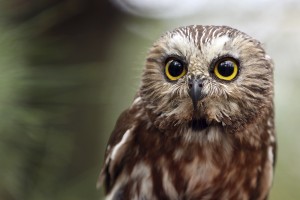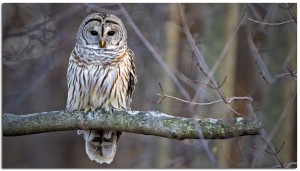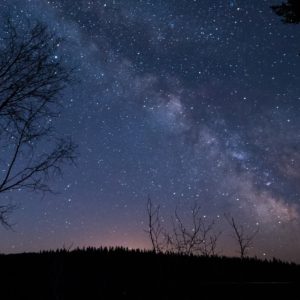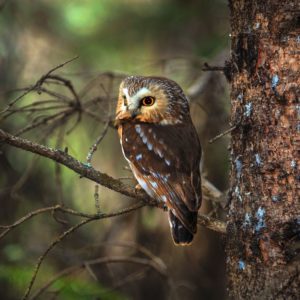Searching for Ontario’s Owls
For volunteers with the Ontario Nocturnal Owl Survey, April means owls! Coordinated by Bird Studies Canada and now in its 19th year, the annual survey is a great opportunity for many of us to get into the field for an evening and contribute to Bird Studies Canada’s collaborative efforts to monitor owls, and other birds, across Ontario and Canada.
An Ontario Nocturnal Owl Survey roadside route consists of 10 pre-determined stops, each about 2 kilometers from the previous point. At each location, a broadcast recording is played which incorporates silent listening periods and owl calls to solicit responses from nearby owls. Within the Ottawa area, the recording focuses on northern saw-whet owls and barred owls. While other species including Great Horned Owls can be heard during surveys, they won’t reliably respond to recorded calls and so aren’t included in the playbacks.

Northern Saw-whet Owl
Once a new route is obtained and the stops are confirmed, running the route becomes relatively simple. Except for the weather, of course! Ideal conditions include calm, cold nights with no rain or snow, and, ideally, no spring peepers to drown out distant owls with their relentless calling. The weather’s been different every year we’ve surveyed so far, with cold temperatures that are downright bitter after two hours of standing still on country roads (interspersed with blasts from the car heater between stops) to warm evenings with temperatures in the low-teens.
This year’s slow start to spring brought nearly perfect conditions as my friend Mike and I headed to our route near Almonte, Ontario. Expectations were high – the previous three years had provided a Great Horned Owl and a high of 9 barred owls, including sightings of pairs that flew to within meters of us to see who the new neighbors were. Would this be the year we heard our first northern saw-whet owl?

Barred Owl Photographer: Phil Brown
Despite dozens of white-tailed deer on the way to our route, light snow cover and a crisp, clear night, our survey was pretty quiet. Only two pairs of barred owls calling distantly at two locations. Barely a sound at the other eight stops, except for the barking dogs we wake up every year.
The low numbers of owls didn’t dampen our enthusiasm. First, you have to try awfully hard not to enjoy a beautiful spring evening. Second, documenting the absence of owls is as important as observing their presence. When compiled with counts from other routes, our data contributes information that helps detect broad trends in owl populations across Ontario. These patterns help us learn about owl ecology and their response to a changing landscape. The scope of the Ontario Nocturnal Owl Survey and other similar programs means that volunteers can contribute a great deal of information that can’t be easily obtained in other ways. These are just some of the benefits of citizen science, and why we’ll be back next spring listening for our first northern saw-whet owl.
We would like to thank guest blogger Mark Hovorka for this post. Mark is a Senior Science Advisor with Fisheries and Oceans Canada. Mark contributed to research on songbirds during his undergraduate and graduate studies, and was a volunteer atlasser with the Ontario Breeding Bird Atlas from 2001-2005. Mark has been participating in the Ontario Nocturnal Owl Survey for 7 years.



